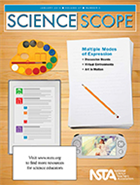Multiple modes of expression
By Mary Bigelow
Posted on 2014-01-18
 There are many ways students can be motivated in science. Some students have a passion for the subject that goes beyond the classroom. Others may find the types of activities in the classroom to be motivational—working with others, using technology, or having options for how they demonstrate their understanding. This issue features articles that describe a variety of creative ways for students to communicate their ideas and share their knowledge.
There are many ways students can be motivated in science. Some students have a passion for the subject that goes beyond the classroom. Others may find the types of activities in the classroom to be motivational—working with others, using technology, or having options for how they demonstrate their understanding. This issue features articles that describe a variety of creative ways for students to communicate their ideas and share their knowledge.
Blending a science unit on motion with art led to an interesting way for students to communicate their understanding of the concepts. Science + Art = Enhanced Learning Experiences for All Students includes several examples of student expression—what a wonderful opportunity for students to express their learning! With the abundance of visuals in science publications, websites, and apps, students can (and should) be producers as well as consumers of these visuals. [SciLinks: Force and Motion]
Physical activity in science lessons can also be motivating for students, such as the projects described in Stomp Rockets: A High-Impact Exploration of Science Concepts*. [SciLinks: Rocket Technology]
Every Assessment Tells a Story describes a classroom-based action research project on alternatives to traditional tests. In a story assessment, students are presented with a narrative and a set of questions or tasks related to it. After trying these assessments along with more traditional ones, the author discovered that scores of assessments with stories were higher than traditional tests on the same concepts. Students indicated that they felt less anxious with the format. Some students even looked forward to them. Two examples are provided, along with guidelines for creating story assessments.
Standardized Test Questions: A Tool for Developing Students’ Proficiency with the Framework’s Science Practices describes strategies and sources for finding test items that assess higher-level thinking and relate to the NGSS. The authors suggest incorporating these items into everyday instruction, such as in exit tickets, writing prompts, and evidence circles. Exploring concepts through virtual environments is the topic of Engage, Elaborate, Evaluate! Virtual Environment-Based Assessments of Science Content and Practices. The authors provide the links to the modules, including the one on weather described in the article. [SciLinks: Weather and Climate]
Many students and teachers are using electronic discussion boards and forums to communicate. If you need some suggestions on how to begin and manage such a discussion, The Leonardo Strategy: Scientific Discourse and Argumentation in an Online Environment* describes the use of a structured format. The teacher poses a stimulus question with an image and students can respond to the question and to other students’ responses. The authors provide examples of stimulus questions and examples of students’ participation. They also share the results of a study on time spent on participation.
Scientific Explanations and Arguments* (this month’s Teacher’s Toolkit column) describes argumentation as “not simply the generation of a final product, it’s an ongoing dialogue through which scientists build new understanding of the natural world.” The authors compare argumentation as a culminating activity with knowledge building; they provide three examples of exploratory argumentation that they used at the beginning of units of instruction on plate tectonics, evolution, and the particulate nature of matter.
Do you have students that are English language learners? The authors of Supporting Linguistically Diverse Students in an Era of Science Education Reform offer six strategies for working with ELL students (or “emergent bilinguals”—what a powerful description) that focus on what these students can do.
Using Place-Based Inquiry to Inspire and Motivate Future Scientists* integrates scientific inquiry with place-based education (in which students learn through direct experience with an environment instead of indirect presentations or textbooks. The lessons described incorporate typical field trip planning with a 5E model to produce a study ecological study of their school grounds. The article includes project ideas, a sample activity sheet, and rubrics. The resources at the end of the article include suggestions for field guides, safety, and tools for exploring the environment.
Exploring concepts through virtual environments is the topic of Engage, Elaborate, Evaluate! Virtual Environment-Based Assessments of Science Content and Practices. The authors provide the links to the modules, including the one on weather described in the article.
*Check out the Connections for this issue (January 2014). Even if the article does not quite fit with your lesson agenda, this resource has ideas for handouts, background information sheets, data sheets, rubrics, etc.
Disclaimer: The views expressed in this blog post are those of the author(s) and do not necessarily reflect the official position of the National Science Teaching Association (NSTA).


